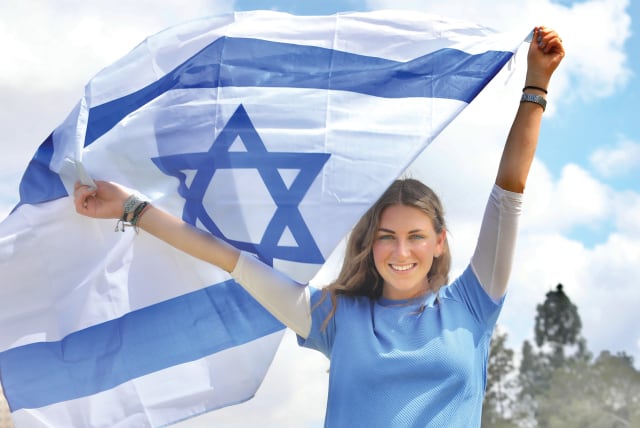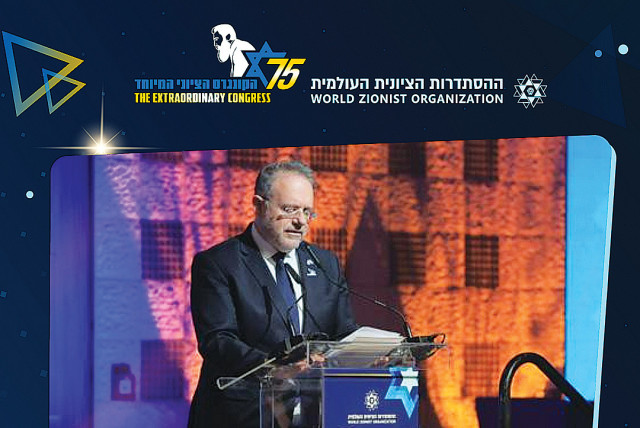Israel at 75: Zionism is becoming more religious, linked with Judaism

As Israel matures, Zionism is morphing and adopting a more religious tone than its secular founders. Was this inevitable? Should it be stopped? How can we adapt?
Abraham was 75 when he left his home to embark upon a journey to the land promised to him by God, setting in motion the beginning of the Jewish people and an eventual nation.
Now, at the same auspicious age, the modern State of Israel finds itself at a similar crossroads as its patriarch. And so does Zionism.
Theodor Herzl, the founder of modern Zionism and organizer of the first Zionist Congress in 1897, believed in pursuing a political solution – an internationally recognized state – to the “Jewish problem” in Europe. However, he also sought the support of leading rabbis of his time.
But as Israel matures, Zionism is morphing and adopting a more religious tone than its secular founders.
“There is clearly a religious revival of Zionism that takes two forms: a religious revival among the seculars while staying secular and… the shift of power from secular minority to religious majority,” says Gol Kalev. “That’s a process of democratization and a process of Israel maturing.”
Kalev argues in his book Judaism 3.0 that Zionism has become the organizing principle of Judaism today, meaning that the two are essentially synonymous. He also postulates that this would not have been possible in Israel’s early years.
“Zionism used to be associated with secularism and a rejection of religion,” he says.
In recent decades, however, Kalev and others have seen a shift in the “Zionist ethos from being about secular symbolism, such as the kibbutz, to being in unison with the Jewish religion.”
Kalev insists that this evolving definition does not exclude secular Israelis, despite its religious overtones. He notes that even in the contentious debate over proposed judicial reforms, both sides carried Israeli flags.
“There is a clear agreement that this is about Zionism and that Zionism is something we strongly believe in. But there is a disagreement about what is the Zionist way,” he observes.
Gil Troy, historian and author of The Zionist Ideas, says Zionism initially succeeded “because it was secular – but ultimately it was legitimate because it was deeply Jewish.”
“The deed to the land came to the Jewish people, it didn’t come to this group of secular pioneers,” he says. Israel was created by a miracle, “but ultimately it was legitimized by the seculars who created a state, army and a declaration of independence.”
Israel and the dance between secular and religious society
Since then, the State of Israel has revolved around the “dance” between secular and religious sectors of society, Troy says.
“We’re both a people and a religion, so it’s not surprising that our national movement and our state would constantly be revolving around those two somewhat confusing, somewhat overlapping, somewhat reinforcing ideas and identities,” he says. Ultimately, the religious dimension cannot be extricated from Zionism, “even at its most secular.”
Indeed, God promised in Ezekiel 11:17: “I will gather you from the nations and bring you back from the countries where you have been scattered, and I will give you back the land of Israel again.”
But some view this religious renaissance of Zionism in the State of Israel as a worrying development, as radicals have co-opted many aspects of the movement.
“Zionism today is identified with the settlers and their Messianic ideology, and this is completely different from what was originally Zionism,” says historian Anita Shapira, professor emeritus at Tel Aviv University.
Herzl, she contends, envisioned Zionism “as a liberal movement that was going to establish a liberal state in Palestine.”
“In the Declaration of Independence, it is stated loud and clear that this was going to be a liberal state. The point when this changed was after the Six-Day War,” she continues. “This is one of the major changes that occurred in the Zionist ideal: that those who carry this idea mix it, to a great extent, with religion. This mixture gives it something that was not there … until the last two decades. It was there, it was growing, we did not pay attention to this growth, but today, this is maybe the most influential power within Zionism. Unfortunately”
Shapira fears that this imbalance could jeopardize Israel’s democracy, along with the rights of women, the LGBT+ community, Arabs and other minority groups. Members of the present government have made “statements that make my hair stand regarding the third temple, regarding evacuating all the Arabs and Jewish supremacy.”
“I cannot stand it, and it was never part of Zionism,” she says.
Hebrew University history professor Arnon Degani views the evolution of Zionism through events that shaped it through the years – including the sudden acquisition of the West Bank, with hundreds of thousands of Palestinian Arabs living there in 1967. Zionism, he says, is “redefined” according to the situation on the ground which required a response from the Jewish people or State of Israel.
“There is internal Zionist politics, capable leaders and movements that take advantage of opportunities and maneuver cunningly, but it has to do, overall, with the things Zionism rubs against,” he says.
This metamorphosis of Zionism also reflects the nation’s demographic shift toward a more religious society. The ultra-Orthodox community in Israel has grown from a few hundred to about 12% of the population. The Religious Zionist camp accounts for 12% to 15% of the population, and a disproportionately higher 30% to 40% in the military officers corps. The Religious Zionism slate came in a stunning third in the November 2022 election with 14 seats.
Rabbi Tuly Weisz, founder of Israel365, agrees that along with this revival of Religious Zionism, “there is a growing chasm in Israel today, and it is unclear if it is between the Left and Right or the religious and non-religious.”
“It doesn’t fall along the same lines as in the past,” he says.
Weisz notes that the secular governments of Yitzhak Rabin and Shimon Peres encouraged settlement of Judea and Samaria for security reasons – and it was the religious who embraced this call, essentially taking on the same role as the kibbutz movement at the founding of the state.
“They saw the spiritual fulfillment, and that is very consistent with Religious Zionist philosophy – that God is using the secular Jews and secular people to further His will,” he says. “Now the secular Israelis are walking back the commitment to Judea and Samaria and leaving the religious in a very perilous security situation. A lot of them are feeling burned by that, so they are definitely doubling down on their commitment to Judea and Samaria, not only for religious reasons but for security reasons.”
Was Zionism meant to be an insistence on the Jewish right to biblical lands or simply to self-determination? Conservative thinker Gadi Taub defines the distinction as Zionism of land vs. Zionism of state.
“In the settlers’ view, the state is a means for realizing ‘our obligation to the Land of Israel through aliyah and settlement work’… yet in the view of mainstream Zionism, the settlement enterprise is a means for reinforcing the state’s sovereignty,” he writes.
He predicts this ending in “a head-on clash.”
“After all, it is clear to any reasonable observer that Israel faces a choice between a large state with an Arab majority and a smaller state with a Jewish majority,” he says. “Loyalty to the Land of Israel has become the most tangible threat to the essence of political Zionism: A Jewish and democratic state.”
Where does this leave Arab and other minority populations in Israel? Kalev believes that there is more of an acceptance of Israel as a Jewish state among Arabs than many think.
“The Arabs have long been in Judaism 3.0 – they never differentiated between Jews and Zionism,” Kalev notes. He also says that more Arabs in Israel have become “Israelicized,” more culturally Israeli.
This religious inclination of Zionism is also seen in recent immigration patterns. While there is always “emergency aliyah” – the most recent example being refugees from Ukraine – the majority of immigrants from North America are now religious. This differs from previous waves that brought more secular Jews to the country.
Troy believes that a conversation with the next generation needs to revolve around “identity Zionism,” which is based not only on “aliyah and God” but emphasizes Jewish traditions and provides a connection to a “3,500-year-old conversation about values, about community, about meaning.”
Zionism, he says, is encompassed in the broader Jewish ethos ranging from defending Israel through military service and on college campuses to fostering the entrepreneurial spirit that characterizes the “Start-Up Nation.”
But Shapira warns that without a thriving secular population, we will see the end of the Jewish state as we know it.
“This is what worries me very much – that the young people, the gifted people, will leave. And who will stay to protect the religious?” she asks. “When (the ultra-Orthodox) are a third of the population, who can provide for them? It’s impossible. There is no state that a third of the population does not work, does not earn its living. And this is something that nobody dreamed about.”
Weisz sees a bright future but a need for greater responsibility. Now that Israel has succeeded in “everything from draining the swamps to building the roads to 5G Internet… we absolutely need to focus on the spiritual phase of Zionism.
“It’s going to look a lot more religious,” he acknowledges. “We need the religious community to act with more wisdom, maturity and responsibility to lead Israel over the next 75 years. The world is looking to us with great expectations.” ■
Jerusalem Post Store
`; document.getElementById("linkPremium").innerHTML = cont; var divWithLink = document.getElementById("premium-link"); if (divWithLink !== null && divWithLink !== 'undefined') { divWithLink.style.border = "solid 1px #cb0f3e"; divWithLink.style.textAlign = "center"; divWithLink.style.marginBottom = "15px"; divWithLink.style.marginTop = "15px"; divWithLink.style.width = "100%"; divWithLink.style.backgroundColor = "#122952"; divWithLink.style.color = "#ffffff"; divWithLink.style.lineHeight = "1.5"; } } (function (v, i) { });

